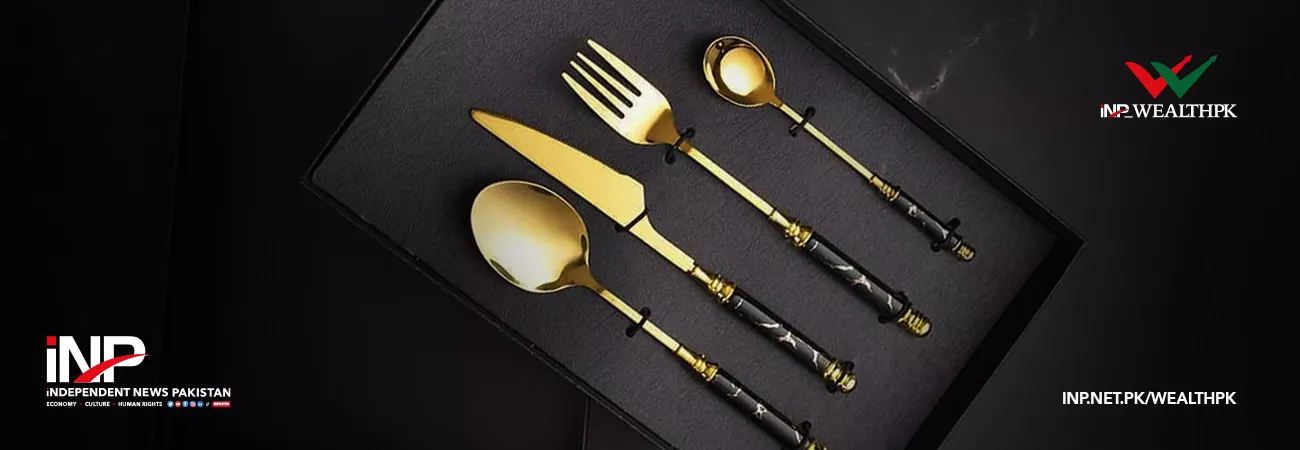INP-WealthPk
Arsalan Ali
The cutlery sector in Pakistan is facing a host of problems which are hindering exports. The problems straitjacketing this industry include manual production processes, limited market access, poor quality, excessive wastage, difficulties in accessing formal financing, and lack of awareness and branding, reports WealthPK.

According to the data released by the Pakistan Bureau of Statistics (PBS), cutlery exports fell by 49 percent to $30.379 million in the first six months of the current fiscal year compared to $59.053 million in the same period last year. The exports remained at $5.340 million in December 2022, up by 13 percent from $4.736 million in Nov 22, but down by 47 percent from $10.049 million in Dec 2021.
According to a report published by the PBS, China is the world's leading exporter of cutlery, followed by Germany and India. The report also stated that Pakistan's cutlery industry lags behind China except in the Damascus steel knives market, where China does not venture due to small-scale production. According to the report, in order to ensure quality, the manufacturers must use imported steel from China because it is of higher quality and is less expensive.
The report stated that Pakistan's cutlery industry relies on the outdated machinery and manual production processes, resulting in low productivity and speed. Despite the presence of donated machinery at the Cutlery Institute of Pakistan, it has remained unused for many years. The report said the cutlery industry is seeking increased protection through higher tariffs on imported cutlery of up to 50 percent. While protectionism undermines competitiveness, it may be necessary for the survival of local industries, it adds.
According to the report, the Pakistani production process faces challenges of poor quality and excessive wastage due to a combination of formal and informal units with subcontracted processes lacking quality control, resulting in a wastage rate of 30-50 percent as opposed to 10-15 percent in other countries.
The report pointed out that the cutlery sector in Pakistan faces barriers to formal financing due to the lack of awareness and an inability to meet documentation requirements. It added that they rely on informal lending, which comes with a high markup.
Due to the difficulties in finding new markets, lack of contact with commercial counsellors, banks’ reluctance to approve LC from non-traditional markets, and payment difficulties, Pakistan exports cutlery primarily to the United States, Germany, the United Kingdom, Saudi Arabia, and Afghanistan, according to the report.
The report emphasizes the importance of improving several aspects of the sector, such as product quality, scaling, and branding, in order to establish itself as a player in the international markets and advance the ‘Make-in-Pakistan’ initiative. The report also suggests that in order to reduce the cost of raw materials, which is the primary impediment, it would be more cost-effective to store imported raw materials in bonded warehouses rather than a raw materials bank, as this would defer the processing of customs duties and taxes until the goods were removed from the warehouse.
The report states that the manufacturers' reluctance to stamp their products with "Made in Pakistan" or their own brand name is impeding their ability to command a premium price and enter new markets. According to the report, the majority of this sector's exports are destined for the United States, Germany, and the United Kingdom, presenting a concentration risk.
It is suggested that the Trade Development Authority of Pakistan (TDAP) explore new markets by organizing exhibitions in potential markets. Based on the report, Pakistan's cutlery exports to the United States are duty-free. Pakistan should capitalize on this by sending trade delegations including cutlery manufacturers to the United States.
Commercial counsellors in the United States may be approached to promote cutlery exports, emphasizing Pakistan's zero-tariff status, it added. The report said the cutlery industry is currently served by three government facilities: the CIP, the small industries estate, and TEVTA. According to a report available with WealthPK, the sector association has recommended the establishment of a training institute for management, branding, and marketing skills and a dedicated institute for cutlery making.
Credit: Independent News Pakistan-WealthPk




